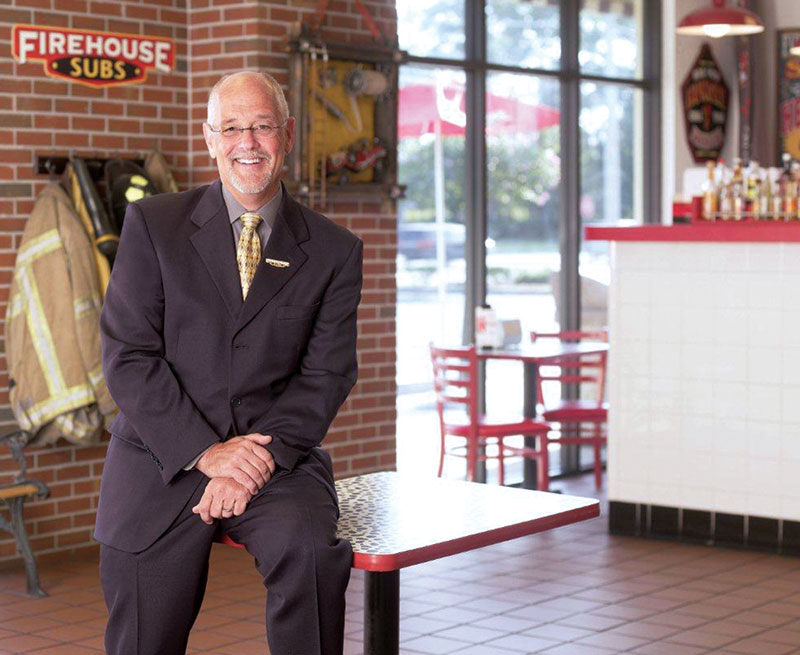Setting strategic objectives, visiting stores, developing franchisee relationships, building a strong organization, mentoring tomorrow’s leaders—CEOs have a lot of responsibilities on their plate. But several chief executives manage to add one very helpful task to their to-do list: getting into the field.
Don Fox, CEO of Jacksonville, Florida–based Firehouse of America, parent company of Firehouse Subs, says visiting his stores is high on his annual priority list, which he assembles at the beginning of each year. Once the company’s main strategic objectives are outlined and set in motion, Fox switches to what he calls a “servant mentality,” where the needs of his staff and his organization become paramount. Nurturing relationships within the franchise community is crucial, Fox says, and should be “non-negotiable in terms of executing it, no matter what else is happening in the system.”
Maintaining a perspective on what’s important is how Phil Friedman, CEO of Charlotte, North Carolina–based Salsarita’s Fresh Cantina, juggles his responsibilities while also visiting his operators.
“You have to realize that the business is in multiple locations, and you need to be present,” he says. That means visiting stores and spending time with franchisees and area management, in addition to putting energy into strategic planning, he says. And though Friedman doesn’t believe field time requires an intense time commitment, he says store employees need to know that when the CEO is there, he is truly present. “By doing that, you’re setting the tone for the organization,” he says.
Pierre Panos, founder and CEO of Alpharetta, Georgia–based Fresh To Order, says his strong leadership team allows him to accomplish a lot, both in the office and in the field.
Panos says he spends his time doing two things: ensuring his team is empowered to tackle obstacles and developing franchisee relationships. Panos says field visits give him a deep perspective on how the business is running. He even schedules in-store meals with others on the team so everyone gets a close-up view of operations.
“I get out of the office and into the stores, taste the food, talk to the guys, pat the managers on the backs, speak to the line staff, and walk behind the line,” he says.
Panos has a hand in nearly every decision affecting the customer experience, and he believes his commitment to spending time in the field gives him a significant advantage in maintaining high guest satisfaction. By being out in the stores, he sees exactly what guests want in real time, which allows him to implement changes when needed. “I’m able to see and react extremely quickly to stores that aren’t performing, products that aren’t working, or things our guests aren’t totally happy with,” he says.
The key benefit of balancing a hands-on approach is that “it keeps you very close to the business, how the business is being operated, and where the dollars are flowing,” Fox says. If too much of your time revolves around headquarters, Fox says, you’re probably missing out on critical information, such as how customers interact with your brand. Even consumer research or satisfaction surveys won’t keep a chief executive in touch closely enough with how things are going.
“If you’re not able to put all of that into some personal context and observation about your business, I don’t think you can use the information nearly as effectively,” Fox says.
There are pitfalls to being in the field, Friedman warns. “You can get so enthralled in one area or another that you’re not providing enough time to those key people who need direction,” he says. A CEO who’s overly involved in a particular area might also smother others’ input, Friedman says, because they feel they’re more in tune with the situation than anyone else.
As Fox commits to field visits and other hands-on management activities, he’s also conscious of the need to encourage collaboration and prevent people from operating in silos. “That’s something that executive management can be in a particularly good position to prevent in an organization,” he says.
Becoming too involved in too many things can also make a CEO lose sight of the “big thing,” Panos says, referring to the goal of providing customers with a great experience. Becoming entrenched in day-to-day minutia can potentially diminish the connection to overall strategic objectives, a scenario Panos says may plague CEOs of emerging brands more often.
Creating a regular cycle for various activities allows more opportunities to be hands on, Friedman says. He often uses a quarterly schedule to determine which stores he’ll visit. In this way, he’s able to get around to each area regularly without being overwhelmed.
Friedman encourages CEOs to rely more heavily on their leadership team as the organization scales up, and to think creatively about how to involve various regional groups. “Instead of having everybody come to headquarters, you may want to do business reviews in the field at a regional office,” he says.
If a CEO can’t execute a strong hands-on methodology, Fox says, it’s time to look for additional opportunities to delegate. “The one thing you can’t delegate is your executive leadership,” he says. “Nobody else can fill that role for you.”







